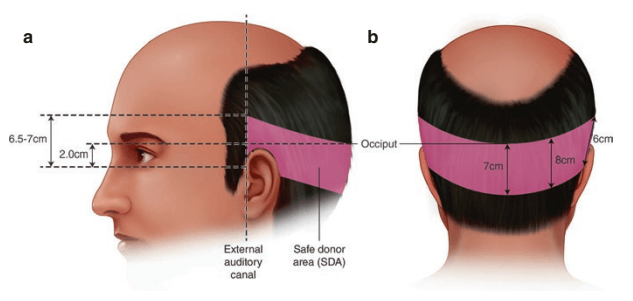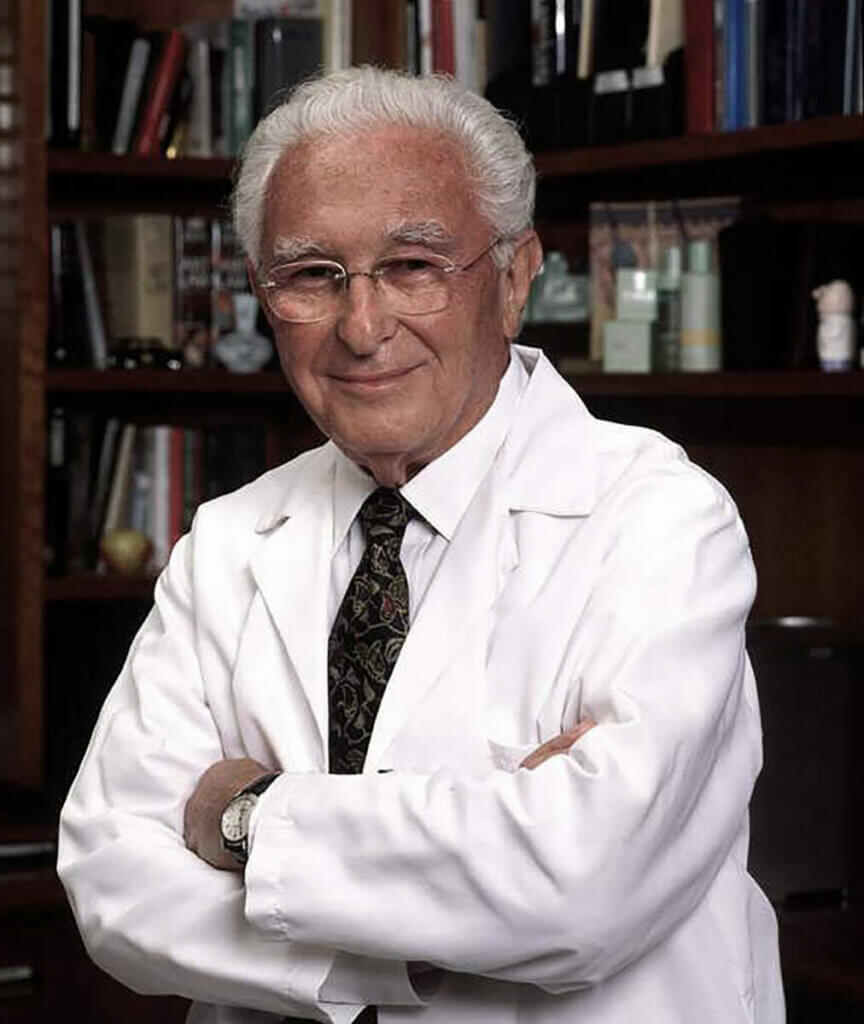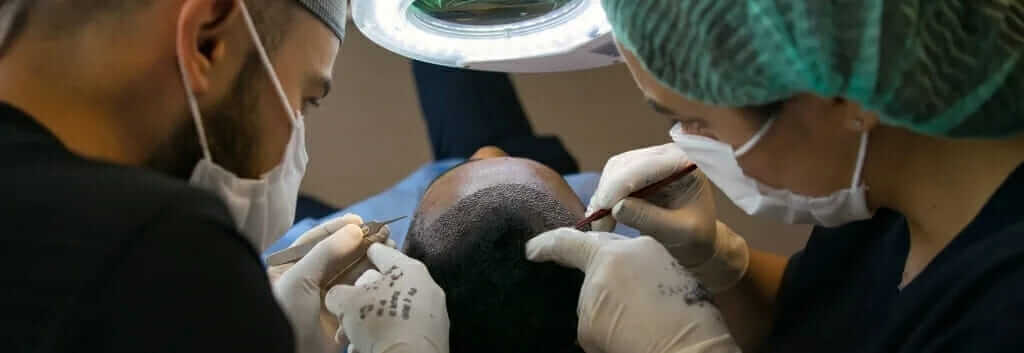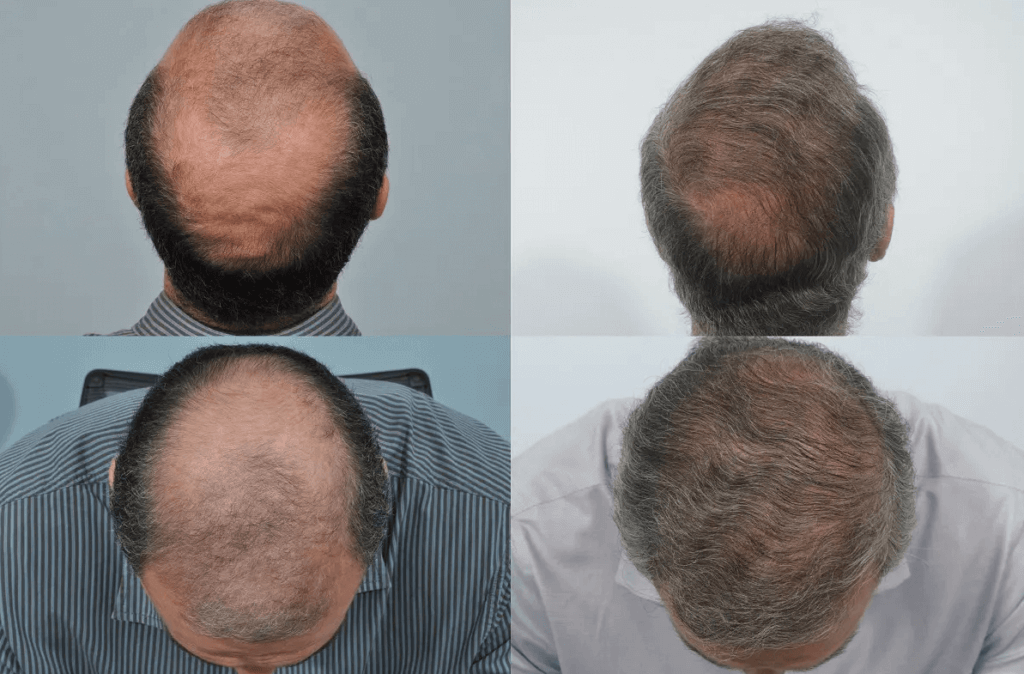The before-after transformations of hair transplant surgeries look fantastic.
They do.
As someone who has seen up close (and caused) many of these transformations, I can say they look even better in real life.
But as someone who’s considering getting a hair transplant, I’m sure you have your doubts, one of them being the common question:
What happens 10 years after the surgery?
And you have every right to ask that.
According to hair loss statistics, between the ages of 25-35, androgenetic alopecia (AGA) and male pattern baldness (MPB) start to display visible effects. Naturally, most patients getting their transplants at these ages wonder if their transplant will stay in their late 30s/early 40s.
TL;DR
▶ The hair transplanted during a hair transplant surgery is from the part of your scalp called the “safe donor area,” which is practically immune to only male pattern baldness and DHT.
▶ Because of this, the transplanted hair will last for long years in the recipient area, safe from balding related to androgenetic alopecia.
▶ But this doesn’t mean that these hairs will not fall out when there are other causes for hair loss.
▶ After a hair transplant, you can keep your entire head of hair for a long time if you adopt a healthy lifestyle and avoid activities harmful to your overall health.
In this article, I’m going to address your doubts and answer the famous question in depth.
Table of Contents
Let’s start with the most important one:
Do Hair Transplants Last Forever?
Most likely, yes, transplanted hair should last forever in theory, UNLESS you give it a reason to fall out other than male-pattern baldness. For almost every patient, a hair transplant can be a permanent solution to AGA under careful supervision.
However, as an ISHRS member, I have to explain what permanent means in this context:
If you are asking whether hair transplants are a magical solution that will stay as completely destructible for a lifetime, then I must say that this is not the case.
We present hair transplants as solutions that can last forever in theory because they are not affected by the chemical processes of balding. However, as balding can still happen due to poor management and external sources, it is important to note that your hair is never entirely safe and you should never let your guard down.
Remember that the true permanent solution against balding that will last forever is proper haircare.
To add more on the matter, here’s how I explain to our daily patients:
Your newly transplanted grafts are immune to the natural effects of MPB only, which is the primary cause of 85% of all baldness in men.
However, we, as hair transplant surgeons, don’t apply a magical cure to your scalp during a hair transplant to provide this quality to your transplanted hair. In other words, although natural causes are prevented with a transplant, other factors can still put your hair in danger.
But first, to explain this immunity further, we need to understand where the transplanted hair comes from:
Where Do They Get the Hair for a Hair Transplant?
Certain parts of your scalp are less affected by DHT (dihydrotestosterone, the hormone that causes pattern baldness) and will stay in your scalp for longer terms.
The hair that’s transplanted into your bald spots is usually from the back of your scalp to the front of the earlobes (the picture below). This area is called the “safe donor area”, and it yields the best donor hair for a hair transplant.
We call this area “safe” because it is safe from any pattern of baldness and androgenetic alopecia.
As unfair as this might sound, it gives you a chance to redistribute your safe hair to the recipient areas of your scalp.

But wait, how does that work?
Is the donor area called “safe” because of the “area” or because of the “hair”?
What is Donor Dominance?
The hair follicles located in the safe donor area are the ones that are immune to AGA only, not the site itself. When these hair follicles are placed into the bald spots, they protect their immunity and stay on this part of the scalp for as long as they can.
This concept in hair transplantation is called “donor dominance”, where the donor organ or tissue protects its characteristics wherever it is placed.
The Invention of the Modern Hair Transplantation 💡

Norman Orentreich was the pioneer of modern hair transplant surgeries.
While studying at NYU’s Dermatology Department in the late 1940s, Orentreich focused his work on balding, male pattern baldness to be specific.
After small experimentations, Orentreich discovered the concept of recipient and donor dominance and realized that a hair transplant where the hair from the safe donor area was distributed towards the bald areas was possible.
He coined the term “donor dominance” during these years, referring to an individual hair taken from an area more resistant to the effects of DHT still remaining as resistant to DHT after being implanted into a place that was highly sensitive to DHT.
Orentreich performed his first hair transplant operation in 1952 on a male patient with AGA, which was followed by hundreds and then thousands of patients with the same condition.
Today, millions of patients annually undergo FUE and FUT surgeries, types of new hair transplant techniques derived from Orentreich’s work.
And that’s why you don’t have to worry about hair loss with your newly transplanted hair; it’ll be there for a long time.
How to Make Sure Your Hair Transplant Doesn’t Fail
If you’ve just had one and you’re in the post-hair transplant recovery phase or planning to get one soon, I know you’ve had some of your doubts go away by the previous answer.
But not all of them, right?
⚠️ Yes, your newly transplanted healthy hair follicles will be immune to AGA, but there are still dozens of reasons for you to go bald.
Although AGA accounts for a significant portion of all balding, you still need to take care of your hair if you want to keep it for a long time.
Here are the key points you need to pay attention to:
1 – Get Your Hair Transplant Done Right
If you want to keep your head full of natural hair, you need to first make sure everything goes according to the books during the surgical procedure.
There isn’t as much that could go wrong during surgery as things could go wrong after the hair transplant surgery, but still, there are some elements you need to watch out for.
First off, you need to make sure you’re working with the right physician/surgeon who is going to operate on you. They need to be a medical doctor working in dermatology (the field that focuses on skin and hair) and an experienced hair transplant surgeon with plenty of satisfied patients.
If you have any doubts, directly ask your surgeon. And if they can answer all of your questions and soothe you while having a good record, you’re in good hands.

Secondly, you need to make sure you’re getting your surgery in the right clinic/hospital. As someone who has seen many instances of both, I’m sure I don’t need to tell you how to distinguish an “unhealthy-looking” clinic from your above-average quality clinic.
The operating room and the whole clinic should look sterile, the equipment should be up to date, and the rooms of the clinic should be the same as the images you were provided; if they mislead you on one topic, they are likely to do it on another one so watch out.
And lastly, make sure you’re getting all the information you need to make the necessary changes before and after a hair transplant.
These requirements are the change-making factors between a success and a failure.
At UnitedCare, we’ve adopted a holistic approach to hair transplantation. We first fix any underlying issues about your hair loss, use up-to-date methods and equipment during the surgery, and assist you with the resources and assistance you need after the hair transplant procedure.
If you want to be a part of this holistic experience and restore your natural look, schedule a free consultation:
A Hair Transplant that will last a lifetime:
UnitedCare and its expert dermatologist doctors provide a holistic approach to FUE surgeries.
2 – Stick with the Post-Surgery Recovery Guidelines
Up to 1 year after the operation is the period that your transplanted hair is the most fragile.
They’ve just been extracted from the back of your scalp and implanted into the bald spots, and it was not a handful of them; it was at least a few thousand tiny hair follicles. They go through a stressful process that can wear them out, prohibit their growth for a while, and even cause some of them to fall out.
So, you need to make sure you’re doing everything right to help these hair grafts survive, which is the main factor determining the success of a hair transplant.
Our in-depth After Hair Transplant Recovery Guide or the Care Assistant Tool provides you with everything you need to follow during this process, so make sure you play by the book.
Additionally, due to the physical stress your body goes through, implanted hair follicles on the recipient area will likely shed for the first 2 months after your hair transplant.
This is normal, and you don’t need to worry unless the hair loss is excessive. If so, consult with your physician.
3 – Avoid Any Cause of Further Hair Loss
So you’ve got through the operation successfully; you’ve even gone an entire year or two and now have your natural hairline and hair back.
But you’re not fully saved.
You need to make sure you’re not causing further hair loss to make your hair transplant fall out. Remember, transplanted hair is ONLY immune to AGA.
I’m not saying you have to protect your hair 24/7 actively; the changes are nothing more than a few modifications and adjustments to your daily routine.
These small changes include:
✅ Reducing/Stopping (if possible) Smoking
✅ Reducing Alcohol Consumption
✅ Regularly Exercising or Doing Yoga
✅ Adopting a Healthy and Balanced Diet
✅ Being Gentle and Careful When Styling Your Hair
✅ Avoiding/Coping with Stress and Anxiety
The reason these post-transplant methods are so vital is because they can directly affect your transplant’s fate despite being safe from AGA:
What may cause my hair to fall out after years?
Since transplanted hair is resistant to the effects of AGA, if you witness your hair falling years after the surgery, it is because of not taking care of your hair investment.
Although these lifestyle changes may seem small, if you do not apply them, poor post-op care can put your transplant in danger years after the surgery, even potentially turning it into a failure:

Remember, getting a hair transplant is your biggest investment; you shouldn’t let your investment go to waste.
For further notice, check out my guide to Causes of Hair Loss to see all the significant causes of balding and how they’re causing hair loss.
Now, let’s see how effective and everlasting hair transplants can be with proper aftercare:
10 Years After a Hair Transplant – what to expect
So, you don’t have to worry about losing your new hairline after a hair transplant surgery and the recovery period.
If you go through each of the steps I’ve mentioned just now, you’ll have a full head of hair through your elderly age.
I’ve seen many hair restoration patients who had their natural look many years after the surgery, even better than most would anticipate.
For example, this photo displays a patient before a hair transplant and 10 years after it, showing that even years after the transplanted hair remains strong and thick:

It’s not hard to have a successful hair transplant that will last you a lifetime if you take the right steps, starting with the first step of all:
What if there was a way you could have 100% hair coverage on your head again?
You can turn that wish into reality in a day with UnitedCare’s expert hands:
Frequently Asked Questions (FAQs)
Will my hair transplant last forever?
Yes, in theory, a hair transplant should forever unless you develop a balding condition other than AGA, which is highly unlikely, statistically speaking, or give your head a reason to experience balding again, such as providing poor post-surgery care. As long as you follow a healthy post-surgery guide to take care of your hair, you can enjoy complete hair growth for a lifetime.
How long does the hair last after a transplant?
After a hair restoration surgery, the transplanted hair lasts for years; most patients even go through their elderly years with a full head of hair.
Can transplanted hair fall out again?
The transplanted hair will not fall out again due to AGA. But if you have any other condition that causes hair loss (which is very unlikely) or follow poor post-op care, you might experience balding again.
What can cause a hair transplant to be not permanent?
Not following proper post-transplant health care to eliminate your initial causes of hair loss, such as reducing stress, can jeopardize the success of your transplant.
How should I care for my hair transplant?
Small daily lifestyle changes can come a long way. Try to avoid excessive stress, reduce smoking and alcohol consumption, and follow a balanced diet supported by regular exercise.
Are hair transplants safe?
Hair transplants have a certain set of requirements for a patient to be an eligible candidate. Ideally, if you fit these requirements and your selected trustworthy physician has approved of your decision, your hair transplant surgery will be relatively safe and smooth.
Are hair transplants painful?
Hair transplants do contain some amount of physical discomfort, yes. However, solely for this reason, we and many other prominent hair transplant clinics use anesthesia during the surgery and painkillers in post-surgery to minimize it as much as possible.
Will I experience hair loss again?
Within the first 2 months after your hair transplant, you may experience some amount of shedding, which is normal and temporary. Other than that, your transplanted hair will be immune to the natural cause of balding, which is MPB. However, other factors can still cause your hair to fall out, so proper care is vital to ensure you do not experience hair loss again.

